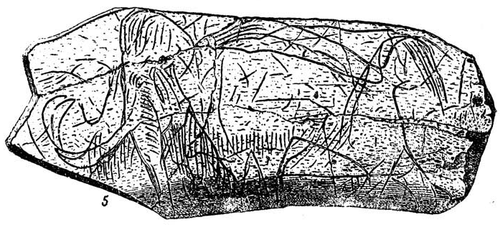Holly Oak Gorget: Difference between revisions
mNo edit summary |
mNo edit summary |
||
| Line 16: | Line 16: | ||
Hilborne T. Cresson, field assistant | Hilborne T. Cresson, field assistant | ||
[[File:mammoth_carved_on_ivory.png|500px| | [[File:mammoth_carved_on_ivory.png|500px|thumb|caption]] | ||
More text | More text | ||
Revision as of 03:36, 3 December 2019
By Haley Allgeyer
The Holly Oak Gorget is a shell pendant, worn as a necklace, with a carving in it of what appears to by a woolly mammoth. This artifact was allegedly discovered in the late 1860’s, by Hilborne T. Cresson, a field assistant at the time at Harvard University’s Peabody Museum. The pendant was found at an archaeological site in northern Delaware. The shell is made of busycon sinistrum, a sea snail, often found along the United States coast of the Atlantic Ocean.

History
Discovered by Hilborne T. Cresson "1864".
La Madeleine
Edouard Lartet discovered La Madeleine pendant that was a carving of a woolly mammoth 1864.
Harvard University's Peabody Museum
Hilborne T. Cresson, field assistant

More text
Pseudoarchaeological Claims
Hilborne T. Cresson
Forgotten Controversy
John Kraft and Ronald Thomas
Modern Understandings
Fake
References
Griffin, James B., Meltzer, David J., Smith, Bruce D., Sturtevant, William C.
1988 A Mammoth Fraud in Science. American Antiquity, 53(3), 578-582. doi:10.2307/281218
Jochim, Michael A.
1985 American Anthropologist, 87(1), new series, 158-160.